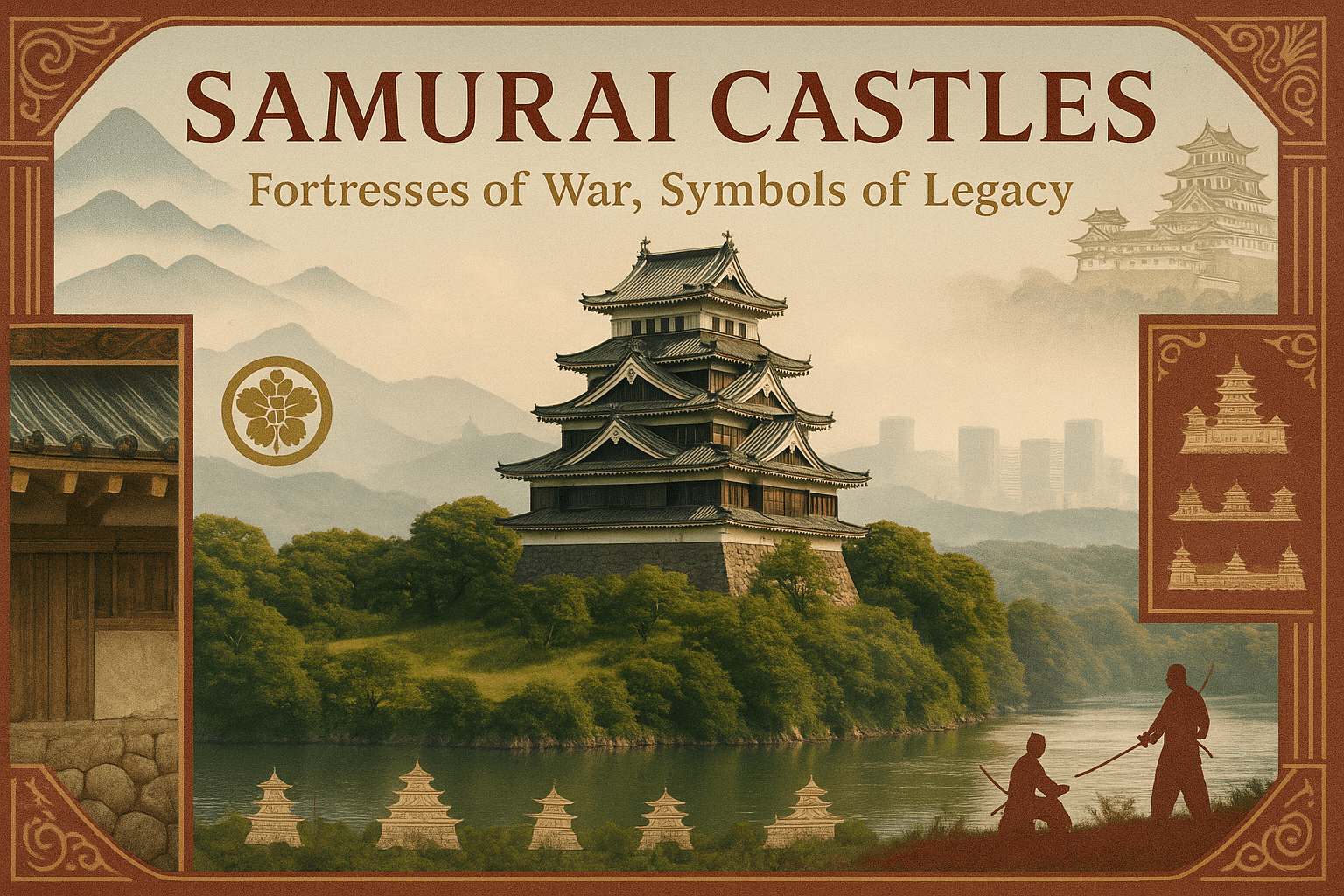Foundations of Authority: The Samurai Castle Origins
Long before the grand moats and towering keeps, samurai castles in Japan began as modest mountain fortresses, or yamajiro. Built during the Heian period (794–1185), these early strongholds were often little more than wooden stockades perched on steep hills, leveraging the natural terrain for defense. Their primary purpose was straightforward: to provide sanctuary and strategic control during frequent clan skirmishes and shifting alliances.
As the power of military clans expanded throughout the Kamakura (1185–1333) and Muromachi (1336–1573) periods, these simple structures evolved. Rising demands for fortified, lasting bases of power led not only to enhanced defense but also to greater displays of influence and legitimacy. Stone foundations replaced dirt mounds, while wooden palisades gave way to sturdier walls and complex gateways. The architecture embraced innovation: watchtowers, multiple gates, and enclosed compounds emerged to support larger contingents of warriors.
This evolution reached its peak during the Sengoku period (1467–1603), a time defined by near-constant civil war and shifting power dynamics. Feudal lords, known as daimyō, transformed castles into vital political, military, and administrative centers, making them lasting emblems of power. Each advance in design and purpose laid the groundwork for the iconic strongholds that would soon dominate Japan’s landscape and symbolize the might of the samurai.
Built for Battle, Shaped by Honor: Castle Architecture
Rising like solemn guardians across the landscape, samurai castles were architectural marvels—designed to intimidate, defend, and inspire reverence. Their brilliance lay in the synergy of strategy and aesthetics. Elevated stone bases (ishigaki) provided formidable silhouettes while discouraging attackers and preventing erosion. The expertly sloped stonework not only strengthened defenses but also reflected samurai values of discipline and meticulousness.
Clever defensive features abounded: moats, sometimes in layered succession, slowed invaders and funneled them into deadly crossfire. Bridges were crafted for easy removal or destruction, providing further strategic advantages. Within the walls, castle layouts became labyrinthine, with narrow corridors, abrupt corners, and concealed ambush sites making every step perilous for intruders.
Yet behind all this martial engineering, samurai castles radiated a unique beauty. White plastered walls gleamed against polished wood, and tiered roofs adorned with ornate tiles created a sense of harmony reminiscent of Zen gardens. The central tenshu (keep) presided over all, serving both as a commanding lookout and a visual statement of power and authority. In every stone, beam, and tile, there was a seamless blend of warfare and wisdom—honor made tangible in architecture.
Centers of Rule: The Castle as Political Heart
Beyond their invincible walls and archer’s slits, samurai castles were the beating hearts of feudal governance across Japan. These fortresses served far more than military purposes; they embodied the very idea of authority, functioning as the daimyo’s residence, a court of law, a tax office, and an administrative hub rolled into one.
Within the fortress’s main keep and administrative wings, daimyo and their trusted retainers orchestrated the management of agricultural policies, land surveys, and carefully regulated the internal affairs of their domain. The surrounding castle town (jōkamachi) fanned out following a strict plan—samurai quarters, merchant zones, and temples all radiating from the castle’s core, reinforcing social order and hierarchy.
A samurai castle’s presence atop a hill or by a river was more than symbolic; it was a daily demonstration of wealth, stability, and regional control. In times of peace, it stood as a marker of order and legitimacy—reminding every subject and neighboring rival that authority rested not just on martial prowess, but also on the orderly governance and stewardship of people and land.
Daily Rhythms Behind the Walls
Within the protective embrace of stone walls, life in a samurai castle unfolded with punctilious order and deeply ingrained tradition. Each day balanced the demands of duty, honor, and social hierarchy, reflecting the core principles of the samurai way.
At dawn, the castle stirred to life. Samurai rose early to engage in rigorous training—swordplay, archery, and horsemanship—both to maintain martial readiness and to cultivate discipline, hallmarks of the Bushidō code. Such practices were as much spiritual exercises as practical preparation for conflict.
Afternoons brought administrative tasks, with high-ranking samurai and retainers overseeing governance, solving local disputes, and ensuring the smooth management of resources. The castle’s craftsmen, scribes, and scholars supported this ecosystem, tending to everything from armor maintenance to record-keeping.
Meals and rituals followed a strict etiquette, with menu and manner determined by rank. Cultural pursuits—tea ceremonies, poetry, calligraphy—intertwined with the martial lifestyle, reinforcing the ideal of the cultured warrior. Lavish halls hosted ceremonial gatherings, reaffirming loyalty to the daimyo and marking the cycle of seasons with ritual and reverence.
As dusk descended, the castle grew quiet. Guards patrolled, lanterns cast gentle light in the corridors, and meditations or prayers prepared the residents for sleep. Every moment behind the walls was governed by discipline—ensuring that, even in peace, the samurai spirit remained vigilant and true.
Iconic Castles and the Clans Who Held Them
Strategically perched atop hills or ringed by moats, Japan’s iconic castles became more than defensive bastions—they stood as enduring stories of power, artistry, and clan ambition. Among the most celebrated are Himeji, Matsumoto, and Kumamoto Castles, each inextricably linked to influential samurai lineages that shaped the nation’s feudal tapestry.
Himeji Castle, often called the “White Heron” for its ethereal beauty, reigns as the most complete and pristine original castle in Japan. Expanded by the Ikeda and Honda clans in the early 1600s, Himeji’s white walls and maze-like defenses exemplify both aesthetic refinement and military acumen. The castle emerged as a shining symbol of Tokugawa-era order and the steadfast rule of loyal warlords.
Matsumoto Castle, known affectionately as the “Crow Castle” because of its striking black façade, offers a contrasting vision. Built during the tumultuous Sengoku period by the Ogasawara clan and later ruled by a branch of the Tokugawa, its flatland position compensated with cunning defenses. Matsumoto represented not just regional strength but the innovative spirit of samurai engineers meeting new strategic challenges.
Down in Kyushu, Kumamoto Castle, originally established by the indomitable Kato clan and later commanded by the Hosokawa family, became legendary for its massive stone ramparts and ingenious defensive features. Its resilience in the face of the Satsuma Rebellion epitomized the strength and tenacity of the clans who claimed it as home.
For the ruling families—the Ikeda, Tokugawa, Kato, and Hosokawa—these castles were simultaneously armories, headquarters, and statements of unyielding authority, shaping both their local domains and Japan’s national destiny.
Echoes Through Time: Legacy and Preservation
Today, samurai castles resonate with more than the echoes of past battles—they endure as powerful emblems of Japanese identity, architectural mastery, and cultural memory. Structures like Himeji, Matsumoto, and Kumamoto have survived centuries of upheaval to become living museums, captivating visitors with their storied walls and timeless beauty.
Their preservation is a matter of national pride. Through meticulous restoration projects, legal protections, and international recognition (such as Himeji’s UNESCO World Heritage listing), Japan ensures these treasures endure for future generations. Skilled artisans keep traditional techniques alive—painstakingly restoring timber frameworks and stone walls—while modern technology discreetly fortifies them against earthquakes and the ravages of time.
Community involvement plays an essential role as well. Local governments, historians, and tourism organizations work in concert to protect, enliven, and share the castles’ stories—turning them into vibrant educational centers and cultural venues. Through festivals, films, and literature, the legend of the samurai castle continues to inspire imagination, connecting Japan’s present to its storied past, and ensuring that the enduring spirit within the stone remains ever alive.





